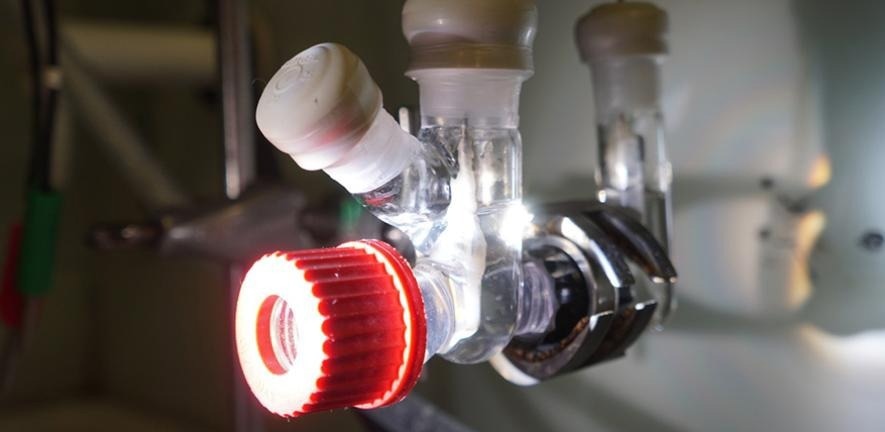Using the sun's energy, scientists devised a system that transforms plastic waste and greenhouse gases into sustainable fuels and other valuable products.

Solar-powered reactor for converting plastic and greenhouse gases into sustainable fuels. Image Credit: Reisner Lab
University of Cambridge researchers devised a system that is capable of converting two waste streams into two chemical products at the same time. It is achieved in a solar-powered reactor for the first time.
The reactor converts CO2 and plastics into various products that can be used across industries. CO2 was turned into syngas, a crucial component of sustainable liquid fuels, and plastic bottles were transformed into glycolic acid, which is widely utilized in the cosmetics industry. By modifying the type of catalyst employed in the reactor, the system may readily be tweaked to yield different products.
Using solar energy to convert plastics and greenhouse gases, two of the most significant challenges to the natural world, into usable and valued products is a vital step toward a more sustainable, circular economy. The findings were published in the journal Nature Synthesis.
Converting waste into something useful using solar energy is a major goal of our research. Plastic pollution is a huge problem worldwide, and often, many of the plastics we throw into recycling bins are incinerated or end up in landfill.
Erwin Reisner, Study Senior Author and Professor, Yusuf Hamied Department of Chemistry, University of Cambridge
Reisner is also the head of the Cambridge Circular Plastics Centre (CirPlas), which strives to minimize plastic waste by combining big ideas with practical solutions.
Other solar-powered “recycling” technologies show promise for addressing plastic pollution and lowering greenhouse gas levels in the atmosphere, but they have yet to be combined into a single process.
A solar-driven technology that could help to address plastic pollution and greenhouse gases at the same time could be a game-changer in the development of a circular economy.
Subhajit Bhattacharjee, Study Co-First Author, University of Cambridge
Co-first author Dr. Motiar Rahaman says, “We also need something that’s tuneable, so that you can easily make changes depending on the final product you want.”
The scientists created an integrated reactor with two distinct compartments: one for plastic and one for greenhouse gases. The reactor employs a perovskite-based light absorber, which is a possible alternative to silicon for next-generation solar cells.
The scientists created various catalysts, which were then integrated into the light absorber. The investigators could modify the end product by changing the catalyst. Under typical temperature and pressure settings, tests of the reactor revealed that it could easily convert PET plastic bottles and CO2 into several carbon-based fuels such as CO, syngas, or formate, in addition to glycolic acid.
The Cambridge reactor produced these chemicals at a significantly faster pace than typical photocatalytic CO2 reduction processes.
Rahaman explains. “Generally, CO2 conversion requires a lot of energy, but with our system, basically you just shine a light at it, and it starts converting harmful products into something useful and sustainable. Prior to this system, we didn’t have anything that could make high-value products selectively and efficiently.”
What’s so special about this system is the versatility and tuneability—we’re making fairly simple carbon-based molecules right now, but in future, we could be able to tune the system to make far more complex products, just by changing the catalyst.
Subhajit Bhattacharjee, Study Co-First Author, University of Cambridge
Recently, Reisner received new funding from the European Research Council to support the development of their solar-powered reactor. The researchers anticipate that in the next five years, they could further develop the reactor to make more complex molecules. According to the investigators, techniques similar to these could someday be employed to develop a recycling plant that is completely solar-powered.
“Developing a circular economy, where we make useful things from waste instead of throwing it into landfill, is vital if we’re going to meaningfully address the climate crisis and protect the natural world. And powering these solutions using the Sun means that we’re doing it cleanly and sustainably,” concluded Reisner.
The study was funded in part by the European Union, the European Research Council, the Cambridge Trust, Hermann and Marianne Straniak Stiftung, and the Engineering and Physical Sciences Research Council (EPSRC), part of UK Research and Innovation (UKRI). Erwin Reisner is a Fellow of St John’s College, Cambridge.
Journal Reference:
Bhattacharjee, S., et al. (2023) Photoelectrochemical CO2-to-fuel conversion with simultaneous plastic reforming. Nature Synthesis. doi.org/10.1038/s44160-022-00196-0.